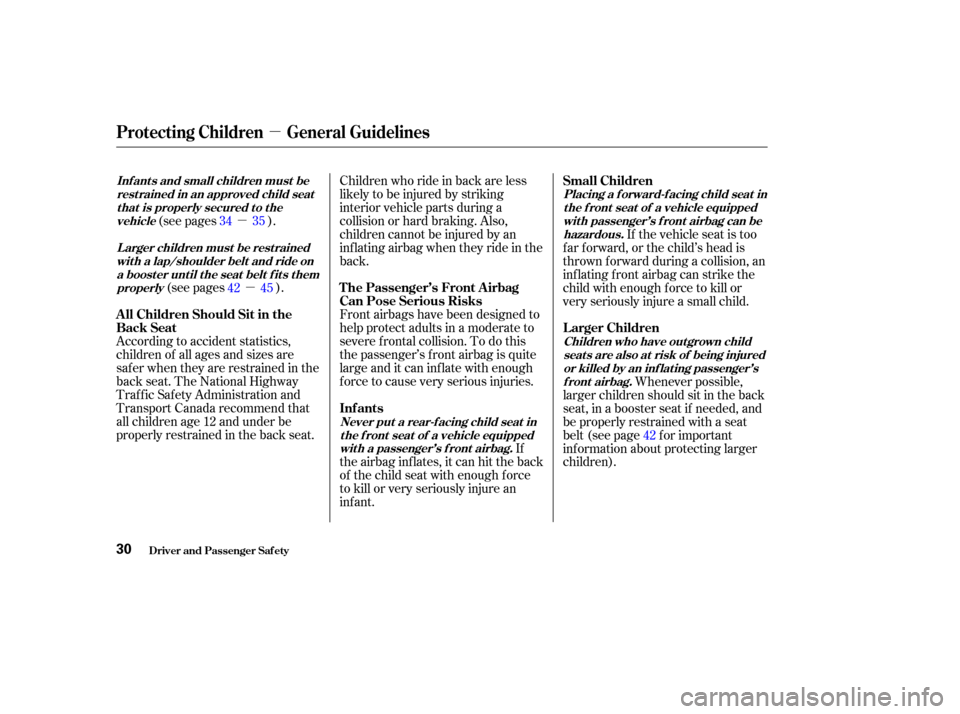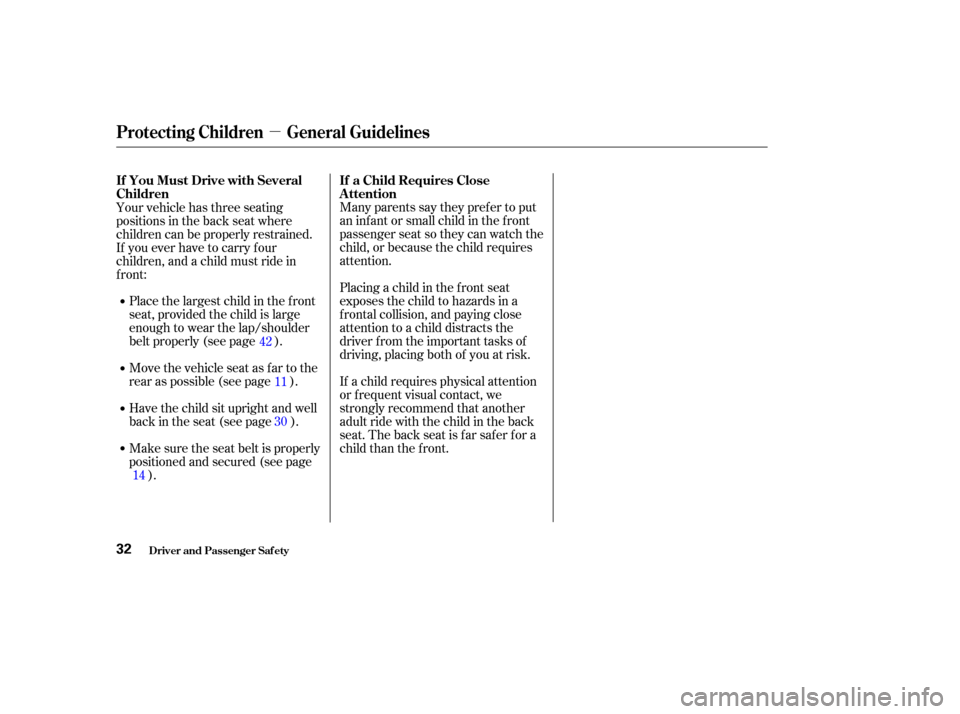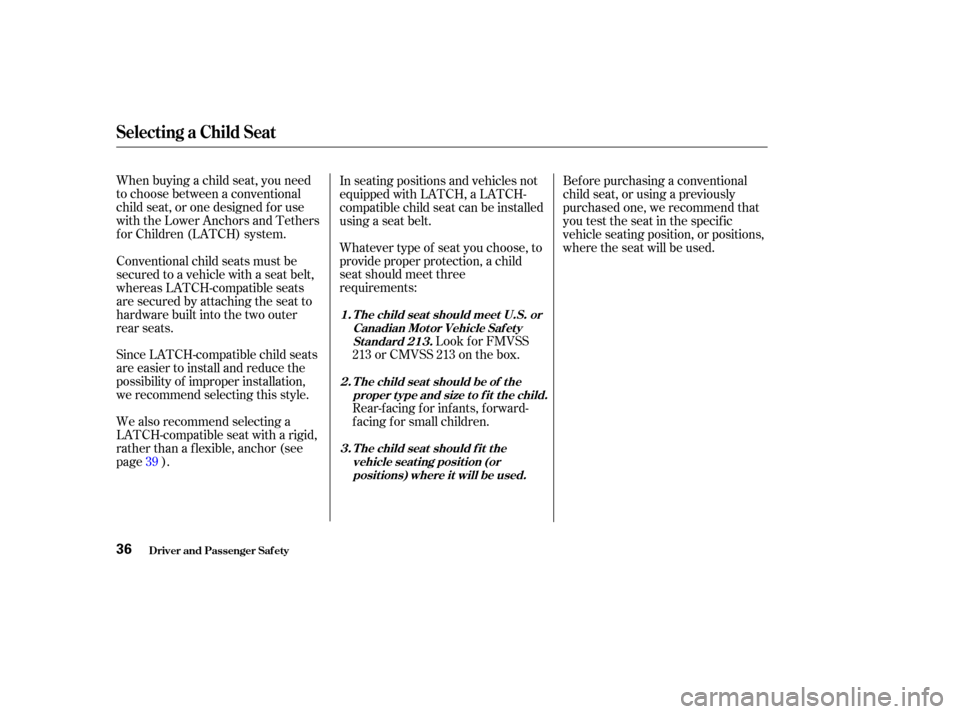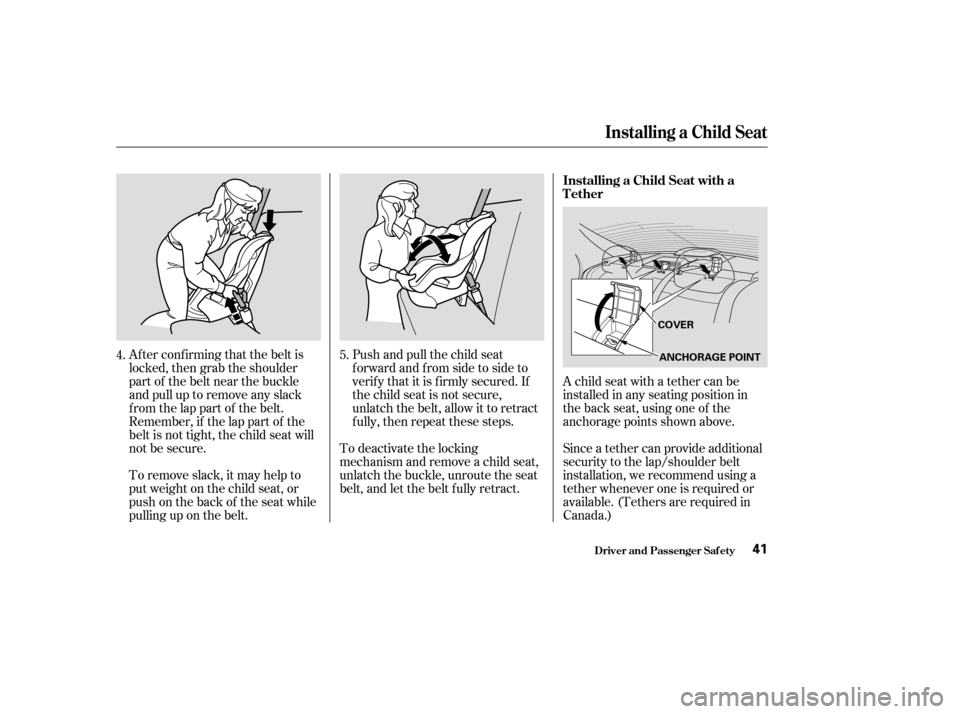Page 33 of 231

�µ
�µ
�µ
(see pages ).
According to accident statistics,
children of all ages and sizes are
saf er when they are restrained in the
back seat. The National Highway
Traffic Safety Administration and
Transport Canada recommend that
all children age 12 and under be
properly restrained in the back seat. Children who ride in back are less
likely to be injured by striking
interior vehicle parts during a
collision or hard braking. Also,
children cannot be injured by an
inf lating airbag when they ride in the
back.
Front airbags have been designed to
help protect adults in a moderate to
severe f rontal collision. To do this
the passenger’s f ront airbag is quite
large and it can inf late with enough
f orce to cause very serious injuries.
If
the airbag inf lates, it can hit the back
of the child seat with enough force
to kill or very seriously injure an
inf ant. If the vehicle seat is too
f ar f orward, or the child’s head is
thrown f orward during a collision, an
inflating front airbag can strike the
child with enough f orce to kill or
very seriously injure a small child.
Whenever possible,
larger children should sit in the back
seat, in a booster seat if needed, and
be properly restrained with a seat
belt (see page f or important
inf ormation about protecting larger
children).
(see pages ).
34 35
42 45
42
Driver and Passenger Saf ety
Larger children must be restrainedwit h a lap/shoulder belt and ride ona boost er unt il t he seat belt f it s t hemproperly
Never put a rear-f acing child seat int he f ront seat of a vehicle equippedwit h a passenger’s f ront airbag. Placing a f orward-f acing child seat in
t he f ront seat of a vehicle equippedwith passenger’s f ront airbag can behazardous.
Children who have outgrown childseat s are also at risk of being injuredor killed by an inf lat ing passenger’sfront airbag.
Inf ant s and small children must be
rest rained in an approved child seatt hat is properly secured t o t hevehicle
All Children Should Sit in the
Back Seat The Passenger’s Front Airbag
Can Pose Serious Risks
Inf antsSmall Children
L arger Children
Protecting Children General Guidelines
30
Page 35 of 231

�µ
Many parents say they pref er to put
an inf ant or small child in the f ront
passenger seat so they can watch the
child, or because the child requires
attention.
Placing a child in the f ront seat
exposes the child to hazards in a
f rontal collision, and paying close
attention to a child distracts the
driver from the important tasks of
driving, placing both of you at risk.
If a child requires physical attention
or f requent visual contact, we
strongly recommend that another
adult ride with the child in the back
seat. The back seat is far safer for a
child than the front.
Place the largest child in the f ront
seat, provided the child is large
enough to wear the lap/shoulder
belt properly (see page ).
Move the vehicle seat as far to the
rear as possible (see page ).
Have the child sit upright and well
backintheseat(seepage ).
Make sure the seat belt is properly
positioned and secured (see page
).
Your vehicle has three seating
positions in the back seat where
children can be properly restrained.
If you ever have to carry four
children, and a child must ride in
front:
11
14 42
30
Driver and Passenger Saf ety
If You Must Drive with Several
Children If a Child Requires Close
Attention
Protecting Children General Guidelines
32
Page 36 of 231

�µ
Neverholdaninfantorchildon
your lap. If you are not wearing a
seat belt in crash, you could be
thrown f orward and crush the
child against the dashboard or a
seat-back. If you are wearing a
seat belt the child can be torn
from your arms and be seriously
hurt or killed.
Never let two children use the
same seat belt. If they do, they
could be very seriously injured in a
crash.
Use childproof door locks to
prevent children f rom opening the
doors. This can prevent children
f rom accidentally f alling out.Do not leave children alone in a
vehicle. Leaving children without
adult supervision is illegal in most
states and Canadian provinces,
and can be very hazardous. For
example, inf ants and small
childrenleftinavehicleonahot
day can die f rom heatstroke. A
child lef t alone with the key in the
ignition can accidentally set the
vehicle in motion, possibly injuring
themselves or others.
Keep vehicle keys and remote
transmitters out of the reach of
children. Even very young
children learn how to unlock
vehicle doors, turn on the ignition,
and open the trunk, which can
lead to accidental injury or death.
Lock all doors and trunk when
your vehicle is not in use. Children
who play in vehicles can
accidentally get trapped inside the
trunk. Teach your children not to
play in or around vehicles. Know
how to operate the emergency
trunk opener and decide if your
children should be shown how to
use this f eature (see page ).
Never put a seat belt over yourself
and a child. During a crash, the
belt could press deep into the child
and cause serious or fatal injuries.
74
Driver and Passenger Saf ety
Additional Saf ety Precautions
Protecting Children General Guidelines
33
Page 39 of 231

When buying a child seat, you need
to choose between a conventional
child seat, or one designed f or use
with the Lower Anchors and Tethers
f or Children (LATCH) system.
Since LATCH-compatible child seats
are easier to install and reduce the
possibility of improper installation,
we recommend selecting this style.
We also recommend selecting a
LATCH-compatible seat with a rigid,
rather than a f lexible, anchor (see
page ).Whatever type of seat you choose, to
provide proper protection, a child
seat should meet three
requirements:
Look f or FMVSS
213 or CMVSS 213 on the box.
Rear-facing for infants, forward-
f acing f or small children. Bef ore purchasing a conventional
child seat, or using a previously
purchased one, we recommend that
you test the seat in the specif ic
vehicle seating position, or positions,
where the seat will be used.
Conventional child seats must be
secured to a vehicle with a seat belt,
whereas LATCH-compatible seats
are secured by attaching the seat to
hardware built into the two outer
rear seats. In seating positions and vehicles not
equipped with LATCH, a LATCH-
compatible child seat can be installed
using a seat belt.
39
Driver and Passenger Saf ety
T he child seat should meet U.S. or Canadian Mot or Vehicle Saf et ySt andard 213.
T he child seat should be of theproper t ype and size t o f it t he child.
T he child seat should f it thevehicle seat ing posit ion (orposit ions) where it will be used.
1.
2.3.
Selecting a Child Seat
36
Page 40 of 231

Af ter selecting a proper child seat,
and a good place to install the seat,
there are three main steps in
installing the seat:All child seats must be
secured to the vehicle with the lap
part of a lap/shoulder belt or with
the LATCH (Lower Anchors and
Tethers f or Children) system. A
child whose seat is not properly
secured to the vehicle can be
endangered in a crash.
Af ter installing a child
seat, push and pull the seat
f orward and f rom side to side to
verif y that it is secure. A child seat secured with a seat belt
should be installed as f irmly as
possible. However, it does not need
to be ‘‘rock solid’’. Some side-to-side
movement can be expected and
should not reduce the child seat’s
ef f ectiveness.
If the child seat is not secure, try
installing it in a dif f erent seating
position, or use a dif f erent style of
child seat that can be f irmly secured.
Make sure the child is properly
strappedinthechildseat
according to the child seat maker’s
instructions. A child who is not
properly secured in a child seat
can be seriously injured in a crash. The f ollowing pages provide
guidelines on how to properly install
a child seat. A f orward-f acing child
seat is used in all examples, but the
instructions are the same f or a rear-
f acing child seat.
Installing a Child Seat
Driver and Passenger Saf ety
Properly secure t he child seat t o
the vehicle.
Make sure t he child seat is f irmlysecured. Secure the child in the child seat.
1.
2. 3.
37
Page 41 of 231
Your vehicle is equipped with
LATCH (Lower Anchors and
Tethers for Children) at the outer
rear seats. The lower anchors are
located between the seat-back and
seat bottom, and are to be used only
with a child seat designed f or use
with LATCH.Small marks are positioned to
indicate the locations of each anchor
point.To install a LATCH-compatible child
seat:
Move the seat belt buckle or
tongue away f rom the lower
anchors.
Make sure there are no objects
near the anchors that could
prevent a secure connection
between the child seat and
anchors.
1.
2.
Installing a Child Seat
Driver and Passenger Saf ety
Installing a Child Seat Using
LATCH
38
MARKS
LOWER ANCHORS
Page 43 of 231
When not using the LATCH system,
all child seats must be secured to the
vehicle with the lap part of a lap/
shoulder belt.
In addition, the lap/shoulder belts in
the back seating positions, and in the
f ront passenger seat, have a locking
mechanism that must be activated to
secure a child seat.With the child seat in the desired
seating position, route the belt
through the child seat according
to the seat maker’s instructions,
then insert the latch plate into the
buckle.To activate the lockable retractor,
slowly pull the shoulder part of the
belt all the way out until it stops,
then let the belt f eed back into the
retractor.
Af ter the belt has retracted, tug on
it. If the belt is locked, you will not
be able to pull it out. If you can pull
the belt out, it is not locked and
you will need to repeat these steps.
1.
2.
3.
Installing a Child Seat
Driver and Passenger Saf ety
Installing a Child Seat with a L ap/
Shoulder Belt
40
Page 44 of 231

Af ter conf irming that the belt is
locked,thengrabtheshoulder
part of the belt near the buckle
andpulluptoremoveanyslack
f rom the lap part of the belt.
Remember, if the lap part of the
belt is not tight, the child seat will
not be secure.Push and pull the child seat
f orward and f rom side to side to
verif y that it is f irmly secured. If
the child seat is not secure,
unlatch the belt, allow it to retract
f ully, then repeat these steps.
To deactivate the locking
mechanism and remove a child seat,
unlatch the buckle, unroute the seat
belt, and let the belt f ully retract. A child seat with a tether can be
installed in any seating position in
the back seat, using one of the
anchorage points shown above.
Since a tether can provide additional
security to the lap/shoulder belt
installation, we recommend using a
tether whenever one is required or
available. (Tethers are required in
Canada.)
To remove slack, it may help to
putweightonthechildseat,or
push on the back of the seat while
pulling up on the belt.
4.
5.
Installing a Child Seat
Driver and Passenger Saf ety
Installing a Child Seat with a
Tether
41
COVER
ANCHORAGE POINT